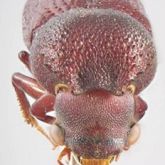Lesser auger beetle
Under Queensland legislation, if you suspect the presence of lesser auger beetle, you must report it to Biosecurity Queensland on 13 25 23 or contact the Emergency Disease Hotline on 1800 675 888.

Lesser auger beetle
© Queensland Government

Lesser auger beetle top back view
© Queensland Government

Lesser auger beetle larvae
© Queensland Government
The lesser auger beetle (Heterobostrychus aequalis) is not established in Australia, but damage consistent with its activity has been found in mango and calliandra timber in Cairns. It is regularly intercepted pre- and post-quarantine at Queensland borders.
The lesser auger beetle is mainly a pest of seasoned hardwood timber, affecting wood and wooden items including unsealed floors, windowsills and furniture. Bamboo items are especially at risk.
Damage occurs entirely below the surface of the wood and isn't usually seen until the wood disintegrates. However, alerts for early detection are the tiny exit holes left by the adults when they emerge from wood and leave behind a sawdust-like material.
Scientific name
Other names
- Boxwood borer
- Trank borer
- False powderpost beetle
- Oriental wood borer
Description
- Beetles have an elongate and cylindrical shape.
- Colouring is reddish-brown to brownish-black.
- Beetles are 6–13mm long and 2–3.5mm wide.
- Beetles are shiny in appearance.
- Males have 2 inward-curving hook-like projections at the back end of the body.
- Larvae are white to yellowish, curved and up to 15mm long.
- See additional details and images on PaDIL.
Distribution
- Not yet established in Queensland. Detections have been associated with imported timber.
- Found in India, Asia, the Middle East, South Africa and Papua New Guinea.
Hosts
The lesser auger beetle has been found in 35 tree species in these genera:
- Adina, Albizzia, Alstonia, Anisoptera and Anogeissus
- Bambusa, Bombax and Boswellia
- Calliandra, Canarium, Cassia and Cedrela
- Dalbergia, Dendrocalamus and Dipterocarpus
- Endospermum and Elaeocarpus
- Garuga
- Koompassia and Kydia
- Lannea and Leucaena
- Mangifera and Morus
- Parashorea, Parishia, Poinciana and Pterocarpus
- Quercus
- Shorea and Sterculia
- Tectona, Terminalia and Toona.
Damage
- Larvae tunnel into the wood, reducing the quality and strength of the timber.
- Larval bore holes are 6–12mm wide and several centimetres long.
- Tiny exit holes are left by adults when they emerge from wood tunnels.
- Fine, sawdust-like evidence appears on the surface of the wood.
- Timber and nearly all hardwood and bamboo products can be affected.
- If established, the beetle could have a devastating effect on native forests, as well as the timber and furniture industries.
Biology
- The time from egg to maturity is 1–6 years.
Control
- Natural spread of lesser auger beetles is slow. However, because they bore into packing cases, boxes, furniture and timber, they are easily transported unintentionally.
- Thoroughly check wood brought into, or stored near, a house or yard to avoid serious infestations.
- Check any wooden items brought into Australia from a foreign country for exit hole and fine, floury frass.
Legal requirements
- If you see the lesser auger beetle, limit its spread where possible and immediately report it to Biosecurity Queensland on 13 25 23. Early detection and intervention is vital to successfully managing this pest.
Resources and research
- Wylie, FR, Peters, BC, 2016, Lesser auger beetle Heterobostrychus Aequalis (Coleoptera: Bostrichidae) in Australia: absent or elusive?: lesser auger beetle in Australia, Austral Entomology, 55(3): 330–333, viewed July 2023.
- Australian Pesticides and Veterinary Medicines Authority (APVMA).
- Contact the Customer Service Centre.